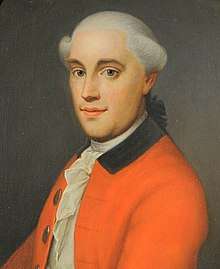Niels Lunde Reiersen
Niels Lunde Reiersen (16 February 1742 - 20 July 1795) was a Danish government official, merchant, silk manufacturer, landowner and philanthropist. He was the owner of the Royal Danish Silk Manufactury in Copenhagen (1775-1796) as well as a founding partner of the leading trading firm De Coninck & Reiersen (1775-1790). He owned Nysø Manor, Oremandsgaard Manor and Lilliendal Manor as well as the estates at Jungshoved and Høfdinggård on Southern Zealand. [1] [2]
Niels Lunde Reiersen | |
|---|---|
 Reiersen painted by Erik Pauelsen in 1784 | |
| Born | 16 February 1742 |
| Died | 20 July 1795 (aged 53) Copenhagen, Denmark |
| Nationality | Danish |
| Occupation | Merchant, industrialist and shipowner |
Early life
Reiersen was born in Copenhagen, the son of bookkeeper Peter Reiersen (1713–73) and Anna Elisabeth Lunde (1719–79). He went to sea as a cabin boy before returning to Copenhagen where he was apprenticed to his father in 1760.[3]
Government official
In 1763, he accompanied a selection of goods to Toruń in Poland. Reiersen was in 1768 appointed as bookkeeper and cashier in connection with a reorganization of Varemagasinet. In 17769, he became a member of a commission which was to oversee the country's factories. In 1874, he was appointed as factory commissioner with special responsibility for Copenhagen. In 777, he was appointed as one of the directors of Varemagasinet. When it closed the following year, he was granted the title etatsråd and appointed a member of the factory commission ( Fabrikdirektionen).[4]
Merchant and industrialist

In early 1775, Reiersen acquired the Royal Danish Silk Manufactury (Den Kongelige Silkemanufaktur) of which his father had become a co-owner in 1760. In 1786, Hans Brandorph joined him as partner.
In 1775–90, he joined Dutch merchant Frédéric de Coninck (1740–1811) as a partner in the trading firm De Coninck & Reiersen. The company took over the remains of the Baltic-Guinea Company (Det det Østersøisk-Guineiske Kompagni in 1787.[5]
Property
Reiersen acquired the estates Nysø Manor, Jungshoved and Oremandsgaard in 1783. In 1785, he also purchased Lilliendal, Høfdinggård and Skuderupgård.[6]
Legacy
Reiersen remained unmarried. He died on 20 July 1795 and was buried at Assistens Cemetery in Copenhagen.
By testament of 30 March 1793, Reiersen left behind his wealth and possessions to Den Reiersenske Fond, a fund to "support the development and progress of industry, both through theoretical and practical measures, in Copenhagen and market towns on Zealand". He left approximately 499,000 Danish rigsdaler. [7]
References
- Povl Engelstoft. "Niels Lunde Reiersen". Dansk Biografisk Leksikon, Gyldendal. Retrieved April 1, 2019.
- "Jungshoved". danskeherregaarde. Retrieved April 1, 2019.
- "Niels Lunde Reiersen" (in Danish). Dansk Biografisk Leksikon. Retrieved 6 February 2019.
- "etatsråd". Den Danske Ordbog. Retrieved April 1, 2019.
- "House of de Coninck & Reiersen". Business Encyclopedia of the Oldenburg Monarchy. Retrieved April 1, 2019.
- "Lilliendal". danskeherregaarde.dk (in Danish). Retrieved 4 February 2019.
- "Det Reiersenske Fond". legatbogen. Retrieved April 1, 2019.
External links
| Wikimedia Commons has media related to Niels Lunde Reiersen. |